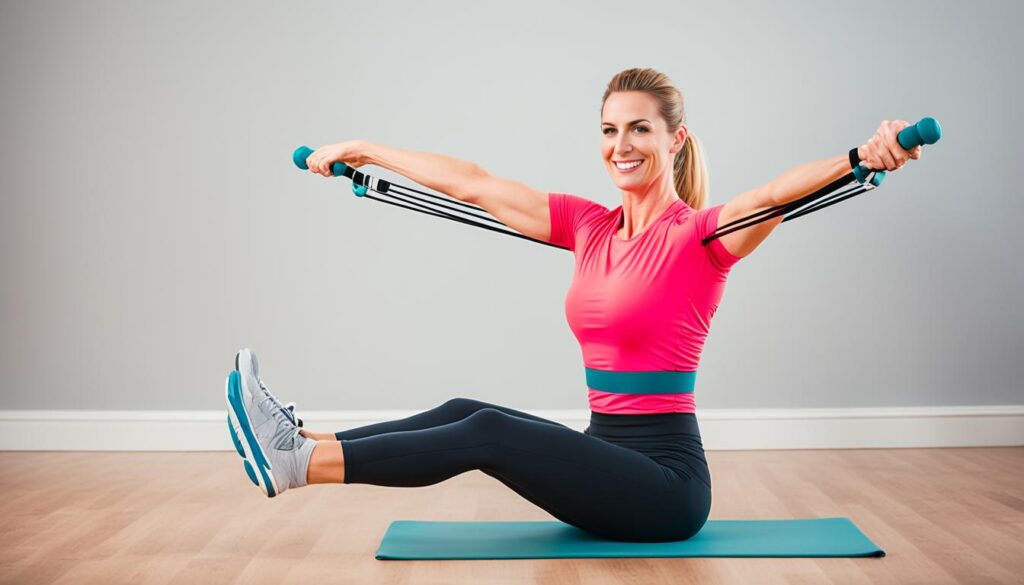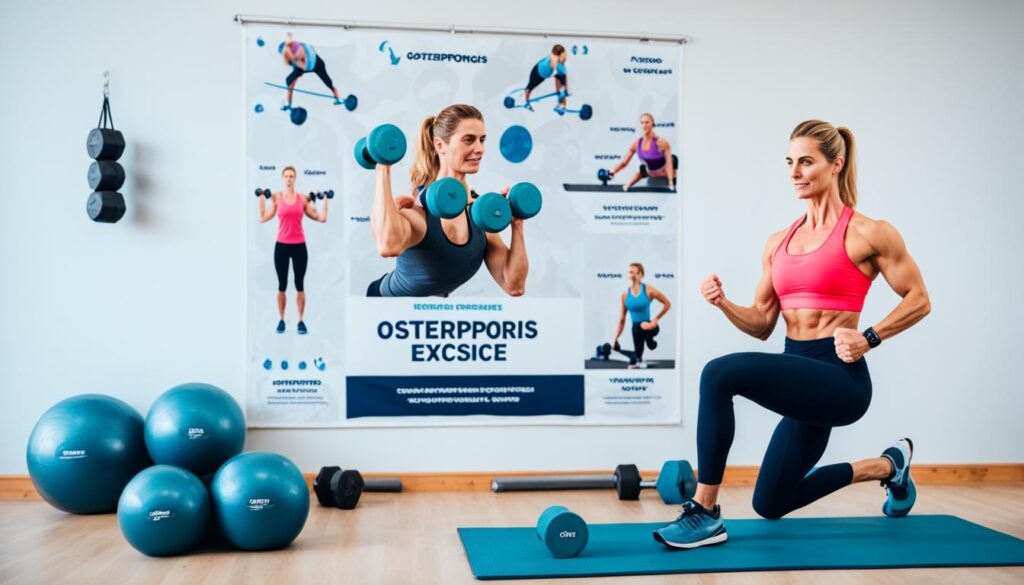Osteoporosis is a condition that affects millions of people worldwide, causing their bones to become weak and brittle. It can lead to fractures and other serious complications, making daily activities more challenging. However, incorporating the right exercises into your routine can significantly improve bone health and reduce the impact of osteoporosis.
When it comes to exercise for osteoporosis, it’s crucial to consult with a doctor first. They can assess your condition, age, and physical constraints to determine the best exercises for you. In general, weight-bearing exercises that challenge muscle strength against gravity are particularly effective in building healthy bones.
While walking, swimming, and other low-impact exercises are beneficial for overall health, they may not provide the optimal stimulus for bone strengthening. To help you get started, here are some of the top exercises recommended for individuals with osteoporosis:
Key Takeaways:
- Exercise is essential for strengthening bones and reducing the risks associated with osteoporosis.
- Consult with a doctor to determine the best exercises for your specific condition.
- Weight-bearing exercises that challenge muscle strength against gravity are particularly effective for building healthy bones.
- Walking, swimming, and other low-impact exercises may not provide the optimal stimulus for bone strengthening.
- Incorporate exercises like foot stomps, bicep curls, shoulder lifts, hamstring curls, and squats into your routine to improve bone strength.
Foot Stomps
Strengthening the hip bones is crucial for individuals with osteoporosis, as they are commonly affected by this condition. One effective exercise to challenge and strengthen the hip bones is foot stomps.
To perform foot stomps, stand upright and imagine there is an empty can beneath your foot. Using your foot, stomp down with force as if you are crushing the imaginary can. This exercise targets the hip area and helps improve bone density.
Aim to repeat foot stomps four times on each foot. If you need additional support for balance, you can hold onto a railing or sturdy furniture while performing the exercise.
| Benefits of Foot Stomps | Instructions |
|---|---|
| Strengthens and challenges the hip bones |
|
Bicep Curls
To build upper body strength and tone the bicep muscles, bicep curls are an effective exercise. This exercise can be performed using dumbbells or resistance bands, providing flexibility and convenience. Both options offer the opportunity to strengthen the muscles responsible for flexing the elbow and lifting objects towards the chest.
When performing bicep curls with dumbbells, start by standing with feet shoulder-width apart. Hold a dumbbell in each hand, keeping the palms facing forward. Slowly lift the dumbbells towards the chest by flexing the elbows, while keeping the upper arms close to the body. The biceps should contract as the weights are lifted. Lower the dumbbells back down to the starting position in a controlled manner. Repeat this movement eight to twelve times for optimal results.

If using resistance bands, step on the middle of the band while holding onto the ends. Ensure that there is enough tension in the band to provide resistance. Perform the same movement as with dumbbells, pulling the bands towards the chest by flexing the elbows and contracting the biceps. Repeat this exercise for eight to twelve repetitions.
Benefits of Bicep Curls
By incorporating bicep curls into your workout routine, you can experience several benefits:
- Improved upper body strength: Bicep curls target the biceps, one of the major muscle groups in the arms. Regularly performing this exercise can enhance overall upper body strength.
- Toned and defined arms: Bicep curls help to tone and define the biceps, resulting in sculpted and shapely arms.
- Functional movement: Strong bicep muscles contribute to various daily activities that involve lifting or pulling objects towards the body.
- Accessibility and versatility: Bicep curls can be easily modified to cater to different fitness levels and can be performed with equipment readily available, such as dumbbells or resistance bands.
Tips for Performing Bicep Curls Safely
Here are some tips to keep in mind when performing bicep curls:
- Engage the core muscles to maintain proper posture throughout the exercise.
- Avoid using momentum to lift the weights or bands. Ensure that the movement is controlled and deliberate.
- Keep the elbows close to the body to maximize bicep engagement and prevent strain on the shoulders.
- Gradually increase the weight or resistance of the dumbbells or bands as your strength improves.
- If you experience any discomfort or pain in the elbows, wrists, or shoulders, consult with a healthcare professional.
Incorporating bicep curls into your upper body workout routine can help strengthen your arms, improve overall upper body strength, and enhance muscle definition. Whether you choose to use dumbbells or resistance bands, this exercise provides a versatile and effective way to target the biceps.
Next, let’s explore another exercise that focuses on the shoulders and upper body strength: Shoulder Lifts.
Shoulder Lifts
Shoulder lifts are upper body exercises that specifically target the muscles in your shoulders and can be a valuable component of weight training for osteoporosis. This exercise can be performed using weights or a resistance band to provide the necessary resistance for muscle strengthening.
To perform shoulder lifts, start with your arms down and hands at your sides. Begin by slowly raising your arms straight in front of you, being mindful not to lock your elbows. It’s important that the lift is comfortable and does not exceed shoulder level to avoid putting excessive strain on the joints.
Shoulder lifts can be repeated eight to twelve times per set, depending on your strength level and fitness goals. Remember to focus on proper form and engage the muscles in your shoulders throughout the movement for maximum effectiveness. As with any exercise program, it’s important to consult with a healthcare professional or qualified trainer before starting a weight training routine.
Adding shoulder lifts to your upper body workout routine can help improve your shoulder strength, stability, and overall upper body strength. By targeting the muscles in your shoulders, you can enhance your posture and reduce the risk of injury. Incorporating weight training exercises like shoulder lifts into your osteoporosis exercise regimen can have a positive impact on your bone health and overall well-being.
Hamstring Curls
Hamstring curls are a great exercise for strengthening the muscles in the back of your upper legs. To perform this exercise:
- Stand with your feet shoulder-width apart.
- Slightly move your left foot back until only the toes are touching the floor.
- Contract the muscles in the back of your left leg and lift your heel towards your buttocks.
- Slowly lower your leg back down.
- Repeat the exercise eight to twelve times on each leg.
Hamstring curls not only target the hamstring muscles, but they also help improve overall leg strength and balance. Incorporating this exercise into your leg routine can be beneficial for individuals seeking to enhance their lower body performance and achieve better balance and stability.
The Benefits of Hamstring Curls
Hamstring curls offer several benefits for individuals looking to improve leg strength and balance:
- Strengthened hamstring muscles: Hamstring curls directly target the muscles in the back of the upper legs, promoting increased strength and stability in this area. Building strong hamstrings can help prevent injuries and enhance athletic performance.
- Improved balance: As hamstring curls require engaging the muscles responsible for balance, regularly performing this exercise can contribute to better overall balance.
- Enhanced coordination: By isolating and targeting the hamstring muscles, hamstring curls can help improve coordination and proprioception, which is your body’s awareness of its position in space.
Adding hamstring curls to your leg exercises can provide a well-rounded workout routine that focuses on specific muscle groups while promoting overall leg strength and balance. Remember to consult with a healthcare professional or fitness expert before starting any new exercise program, especially if you have any pre-existing medical conditions.
Squats
Squats are a highly effective lower body exercise that targets the muscles in the front of the legs and helps strengthen the buttocks. To perform squats, start by positioning your feet hip-width apart. For balance, lightly rest your hands on a sturdy piece of furniture or counter. Slowly bend at the knees, keeping your back straight and slightly leaning forward to engage the leg muscles. Remember to maintain proper form throughout the exercise.
By incorporating squats into your fitness routine, you can build strength and stability in your lower body while also toning your buttocks. Aim to repeat the squat movement eight to twelve times for optimal results. As you progress, you may choose to increase the intensity by using weights or resistance bands. Additionally, you can experiment with variations like sumo squats or squat jumps to further challenge your muscles.
Including squats in your workout regimen can offer a multitude of benefits. Not only do they target key muscle groups like the quadriceps, hamstrings, and glutes, but they also promote improved balance and posture. Regularly performing squats can enhance your overall lower body strength and stability, making everyday activities easier and reducing the risk of injuries.

